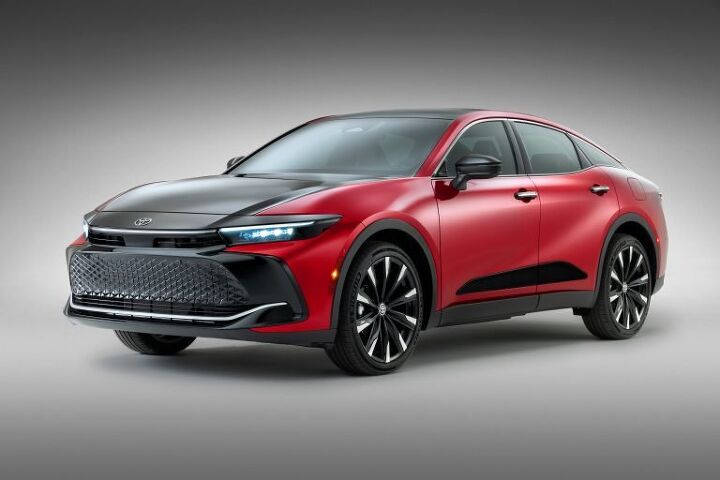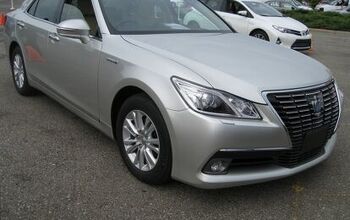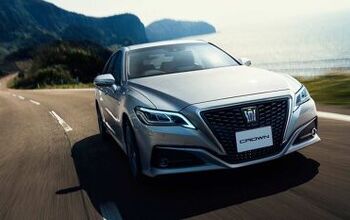Crown Royal: Toyota Crown Returns to America

Students of automotive history will know the Toyota Crown has sat atop the aspirational ladder in Japan since the 1950s and hasn’t been part of the Big T’s portfolio in America since 1973 when it was replaced by the Corona. Our own Murilee can expound on this family tree in excruciating detail, which is one of the many reasons we appreciate his ramblings.
Now, the Crown in back in this country. Technically replacing the Avalon, it’s a hybrid-powered four-door vehicle (car? SUV?) with a conventional sedan trunk opening sitting on a structure that places it four inches higher than a Camry. If Toyota was looking to defy categorization as it brought the Crown name back to America for the first time in five decades, it has definitely succeeded.
There will be three trim levels, all of which will be familiar to the Toyota faithful – XLE, Limited, and Platinum. Powering the first two is a 2.5-liter four-banger which has a nickel-metal hydride battery pack and three electric motors as its dance partners. This configuration is good for a claimed 236 horsepower and knocks on the door of 40 mpg in combined driving conditions with its CVT. Thanks to the placement of those motors, these Crowns are all-wheel drive.
Platinum-grade models are the recipient of an annoyingly capitalized HYBRID MAX powertrain, which we henceforth will never capitalize again. Here, we find a 2.4-liter turbocharged four-cylinder engine mated to a six-speed, wet-clutch transmission which does the two-step with a hybrid system made of a battery and two electric motors, the latter of which is liquid-cooled on the rear axle. Toyota says these gubbins make 340 horsepower, but fuel economy drops to an estimated 28 mpg on the combined cycle.
The snazzier hybrid system flings power to all four wheels consistently, while the XLE and Limited trims can be front-wheel drive in certain conditions. Thanks to the Hybrid Max’s rear motor which generates power through water cooling, Platinum trims can send up to 80 percent of its power to the rear wheels for – hopefully – tail-out action on loose surfaces.
But what about its appearance? What, indeed. Using the TNGA-K platform, it seems like the Crown is attempting to meld sedan driving comfort with crossover-like ride height. If you want to reference the Subaru Legacy SUS or AMC Eagle Sedan in the comments, we won’t stop you. Taking a measuring tape to the Crown offers an overall height of 60.6 inches (compared to 56.9 for a Camry), length of 194.0 inches on a 112.2-inch wheelbase, and 72.4-inch width.
For reference, a 2022 Highlander is listed as being 68.1 inches tall, 194.9 inches long (112.2-inch w/b), and 76.0 inches wide. If you’ve noted its wheelbase is identical to the Crown, give yourself a gold star. Both vehicles are built using the TNGA-K bones which currently underpin a yaffle of Toyota vehicles from Venza to Sienna and RAV4 to Camry. The old Avalon used it as well. The Crown’s interior is familiar to anyone who’s been in a new Toyota recently, which isn’t a bad thing.
Availability is set for this autumn, though Toyota was mum on price. For what it’s worth, the 215-horsepower Avalon Hybrid currently starts at $37,850 so we expect the Crown to push past $40k to start.
[Images: Toyota]

Matthew buys, sells, fixes, & races cars. As a human index of auto & auction knowledge, he is fond of making money and offering loud opinions.
More by Matthew Guy
Latest Car Reviews
Read moreLatest Product Reviews
Read moreRecent Comments
- Amy I owned this exact car from 16 until 19 (1990 to 1993) I miss this car immensely and am on the search to own it again, although it looks like my search may be in vane. It was affectionatly dubbed, " The Dragon Wagon," and hauled many a teenager around the city of Charlotte, NC. For me, it was dependable and trustworthy. I was able to do much of the maintenance myself until I was struck by lightning and a month later the battery exploded. My parents did have the entire electrical system redone and he was back to new. I hope to find one in the near future and make it my every day driver. I'm a dreamer.
- Jeff Overall I prefer the 59 GM cars to the 58s because of less chrome but I have a new appreciation of the 58 Cadillac Eldorados after reading this series. I use to not like the 58 Eldorados but I now don't mind them. Overall I prefer the 55-57s GMs over most of the 58-60s GMs. For the most part I like the 61 GMs. Chryslers I like the 57 and 58s. Fords I liked the 55 thru 57s but the 58s and 59s not as much with the exception of Mercury which I for the most part like all those. As the 60s progressed the tail fins started to go away and the amount of chrome was reduced. More understated.
- Theflyersfan Nissan could have the best auto lineup of any carmaker (they don't), but until they improve one major issue, the best cars out there won't matter. That is the dealership experience. Year after year in multiple customer service surveys from groups like JD Power and CR, Nissan frequency scrapes the bottom. Personally, I really like the never seen new Z, but after having several truly awful Nissan dealer experiences, my shadow will never darken a Nissan showroom. I'm painting with broad strokes here, but maybe it is so ingrained in their culture to try to take advantage of people who might not be savvy enough in the buying experience that they by default treat everyone like idiots and saps. All of this has to be frustrating to Nissan HQ as they are improving their lineup but their dealers drag them down.
- SPPPP I am actually a pretty big Alfa fan ... and that is why I hate this car.
- SCE to AUX They're spending billions on this venture, so I hope so.Investing during a lull in the EV market seems like a smart move - "buy low, sell high" and all that.Key for Honda will be achieving high efficiency in its EVs, something not everybody can do.







































Comments
Join the conversation
Ok, fellas. This proves Toyota was listening when you told us about sedans and your hip joints. Who's buying one first?
This thing is as bloated as a the average housewife at McDonald's.